North Island, New Zealand
When it’s Spring here in the States, it’s Fall in New Zealand—a great time for a golf vacation because the heat of summer is over and the comfort level is just right. It’s a good time for visiting wineries, too, because the fall harvest will be in full swing through May and the winemakers will be making room for the new vintages. There are bargains to be had—but then, the NZ wines are so good almoaust any one of them is a bargain.
New Zealanders take their nickname, Kiwi, from their national icon, a nearsighted bird that has tiny stubs where its wings were eons ago. It’s loveable, but the shy, flightless kiwi is a strange symbol for a country that pioneered the practice of jumping off high places with only a rubber band around your ankles to save you from sudden death. In fact, almost every radical adventure sport practiced today originated in New Zealand.
Kiwis don’t seem to have a death wish. In fact, they enjoy life more than any other people I’ve ever met. Perhaps that’s because the country has the cleanest air in the world, no poisonous critters, and produces some of the world’s finest wines, along with some pretty terrific beef, lamb, venison, prawns, oysters and clams. And the golf . . . .well, there are lots of reasons to double-check the bungee and live to play another day. New Zealand is second only to Scotland in courses per capita.
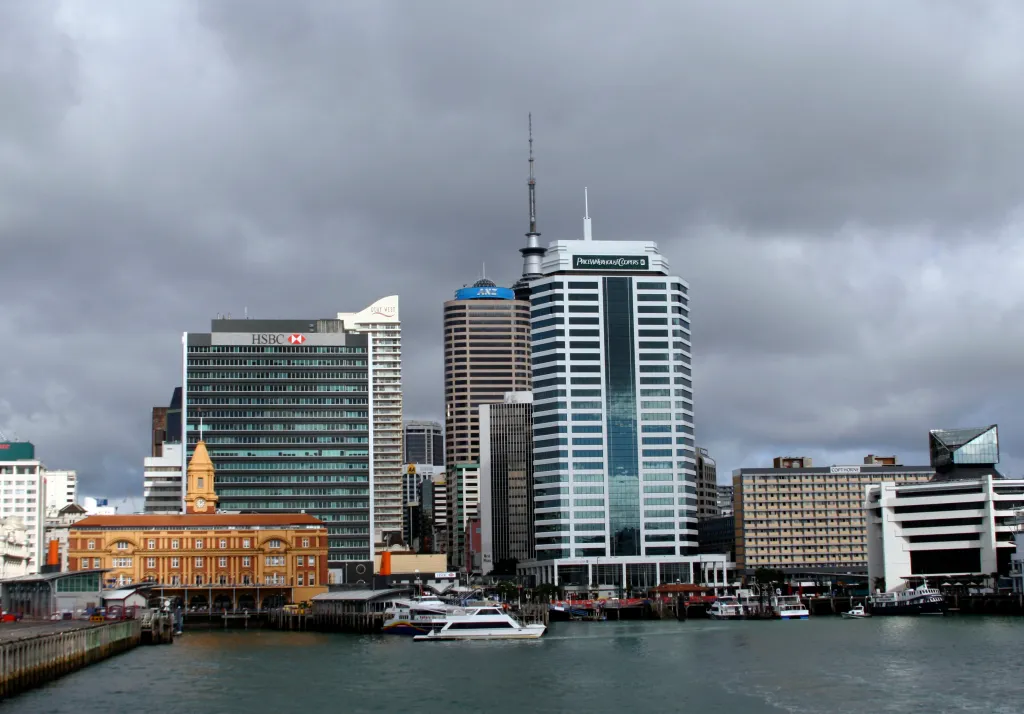
North Island — Auckland
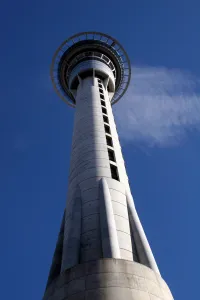
We sampled some fine kiwi wines on the 12-hour Air New Zealand flight from Los Angeles to Auckland and were still lightheaded when we checked the view from our 20th-floor room in the downtown Sky City Grand Hotel. Across the street the Kiwis had built the Sky Tower, the tallest tower in the Southern Hemisphere, for one reason—to jump off it. Clipped to a cable, you step off and freefall 630 feet, decelerating just before reaching the ground.
Deciding we did not have the time to spare (the fall takes about 16 seconds) we took a ferry across Auckland’s scenic harbor (it’s known as the “City of Sails”) to Waiheke Island, an idyllic place reminiscent of Tuscany. More than 30 small vineyards marched in tidy rows across the hills alongside olive groves and pastures where horses, cattle and sheep grazed. The island has made its mark internationally with cabernet sauvignon, pinot gris, syrah, chardonnay and viognier. We sampled delicious wines at several vineyards, including Mudbrick and Te Whau (Maori for “bliss”).
During our first tasting I was aghast when the vintner opened a bottle with a twist-off cap. Was he testing us with Ripple? Sacre bleu, the French would say. Faced with dwindling supplies of good cork, winemakers in New Zealand and Australia have banished the problem of cork taint, ignoring plastic corks and going straight to metal twist tops. No worries, they say, the rest of the world will catch on.
Auckland’s leading international golf venue is the Gulf Harbour Country Club, a Robert Trent Jones Jr. design. It has some tough, scenic holes, especially on the back nine. The 16th has been compared to the eighth at Pebble Beach or the 17th at Cypress Point. The dogleg par four crosses a ravine and flirts with ocean cliffs along its right side. Going for the green risks a flight over water.
Bay of Islands
From Auckland, we drove south to Kauri Cliffs, a David Harman design that leapt into the world’s top 100 before the paint was dry on the tee markers. We arrived after dark at the Lodge at Kauri Cliffs and followed a softly lighted path through the woods to our cottage. The door opened onto a suite (one of 16 on property) brimming with warmth and comfort, with deep lounge chairs before a crackling fire.
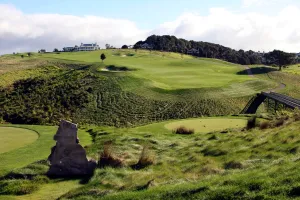
In the rustic, elegantly appointed main building, we dined on fresh local seafood and lamb prepared by a masterful chef. The lodge has a rugged, masculine atmosphere, with fireplaces, big leather chairs and Maori art, but there’s a softer side to the resort—a sumptuous spa with a 100-foot indoor lap pool, and several programs geared to women. It’s ranked tenth on Andrew Harper’s list of top 20 international hideaways. No surprise there.
The golf course occupies nearly 800 acres of hilly woods and fields and Jurassic Park-style gullies from which no ball escapes. Fifteen holes overlook the Bay of Islands, often from cliffs that drop hundreds of feet to the sea. The view (especially from the cliff-side 15th tee) sweeps across miles of ocean, Norfolk pine copses and meadows with no sign of human habitation. Wind buffets the wide fairways and large, sculpted greens. There are ocean holes on both nines, but holes 13 through 17 literally take your breath away, not only with the views but with the tests they present.
The 6,000-acre resort is owned by Julian Robertson, an American hedge-fund legend who’s also the man behind Cape Kidnappers, another world-renowned New Zealand course.
Karikari Peninsula

Further north, in the warm area of New Zealand closest to the equator, we found the 3,500-acre Carrington Farms, which encompasses the Karikari Vineyard & Winery, an Angus farm, eco-lodge and golf club. The peninsula is narrow here, and the estate is home to 900 acres of restored wetlands teeming with wildlife and bordered by long, deserted beaches. The Matt Dye-designed golf course follows gentle hills sloping down to the Pacific. The resort’s Michelin Star-trained chef wowed us with local fare–fresh oysters, mussel chowder and succulent Angus steaks,
served with fine estate wines.
Rotorua
The next day we drove seven hours south to Rotorua. The earth around us breathed steam as if a family of dragons lived underground, and there were boiling mud pools and geysers interspersed with lakes so clear we could spot big trout deep below. That evening we were treated to entertainment and a traditional hangi (earth oven meal) by members of the Tamaki Maori Village. The region is the heart of the Maori culture, as well as one of the world’s best places for fishing and other outdoor pursuits.
Rotorua’s Wairakei International Golf Course is one of the country’s finest parkland layouts. Built in 1970, the track is long (7,033 yards) and studded with 108 bunkers, but it’s a beauty—well-groomed, with huge trees, a meandering stream, banks of flowers and hundreds of colorful birds. A “don’t miss” course, it’s on the route between Kauri Cliffs and Cape Kidnappers.
Outside of Rotorua, we drove deep into a 2,500-acre game preserve to a stone and timber retreat built in the style of Frank Lloyd Wright. Crossing over a trout stream across the entrance, we entered a great room with 35-foot-high ceilings, a vast fireplace and trophy animals gazing down from the walls. Treetops Lodge is the dream of entrepreneur John Sax, whose passion is restoring and protecting New Zealand’s natural treasures. Fortunately, he shares his sanctuary with guests from all over the world who are keen on hunting, fishing, riding, hiking and fine dining. There are four lodge

guestrooms and eight villas in the surrounding woods. When I saw the name on my key, I knew fate had brought me here. I, who grew up in Falling Waters, West Virginia, slept that night in the Falling Water room.
Hawke’s Bay
Hawke’s Bay, on the North Island’s east coast, is New Zealand’s leading food and wine region, and its dry, Mediterranean-like climate makes it a popular tourist destination. An increasing number of visitors are golfers drawn to Cape Kidnappers, which occupies a site so spectacular that even the architect, Tom Doak, vows there is no other golf course like it in the world.
A long mountain road led to the clubhouse, a simple building of tin and rough-hewn boards much like the ubiquitous sheep stations. The interior was decorated with shearing tools, and a comfortable bar promised sustenance after the battle.
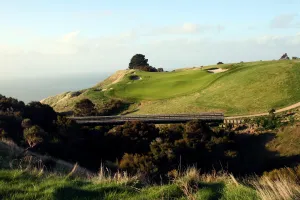
And a battle it was. Cape Kidnappers occupies a treeless emerald expanse on bluffs 1,600 feet above Hawke’s Bay. Fingers of land end at the abyss, with greens and tees at their tips. A brutal wind shrieked unchallenged across the open terrain, and the wide fairways shrank every time I struck the ball. It was a grueling round, but an awesome visual experience. In November 2007, the Farm at Cape Kidnappers opened, luxury lodging in the guise of a sheep station.
We stayed in the little town of Napier, at the
c.1909 County Hotel. The old-fashioned beauty is run by a young couple who know everyone in town. In fact, the entire town seems to congregate in the hotel’s Churchill Bar, a rollicking place with Sir Winston’s quotes painted freehand on the walls. Outside of Napier, vineyards stretch as far as the eye can see, and we stopped to picnic at Morton Vineyards and sample some of the sublime pinot noirs and sauvignon blancs exported to the U.S.
We flew on to New Zealand’s South Island for more golf, wine and exploring . . . but that’s a story for another day. It’s hard enough to scratch the surface of the North Island in a couple of weeks.
Tags:
About Dale
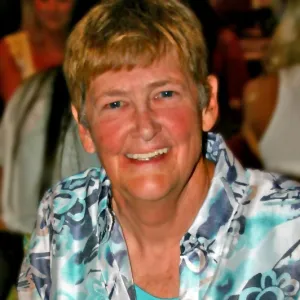
In the course of her life, she has exercised racehorses at New York's Belmont Park, shown jumping horses on the A Circuit, driven a race car with the late Paul Newman, and played the world's most famous golf courses. She is a former private pilot and an avid scuba diver. Read More...

In the course of her life, she has exercised racehorses at New York's Belmont Park, shown jumping horses on the A Circuit, driven a race car with the late Paul Newman, and played the world's most famous golf courses. She is a former private pilot and an avid scuba diver. Read More...
